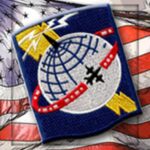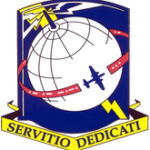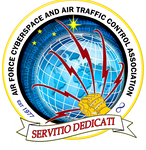History
How it began…
Formerly called the AACS Alumni Association (1977 to 2008), AACS stood for both the Army Airways Communications System and the Airways and Air Communications Service. Over the years, because the missions were basically the same, the AACS Alumni Association expanded membership to include AFCS, Air Force Communications Command (AFCC), Air Force Command, Control, Communications & Computer Agency (AFC4A), Air Force Communications Agency (AFCA), Air Force Flight Standards Agency (AFFSA), and other Major Commands up to and including today’s Air Force organizational structure. TAX STATUS The Air Force Cyberspace and Air Traffic Control Association is an IRS Code 501(c)(3) organization. In accordance with current IRS tax regulations, donations to the Association are tax deductible when filing a IRS Form 1040. ALUMNI ASSOCIATION HISTORY The AACS Alumni Association was formed on Sept. 30, 1977. Larry and Doris Camp were visiting Dux and Pearl LeDoux in Eunice, LA in the fall of 1976 when the subject of old military friends came up. Larry and Dux were assigned to the 5th Army Airways Communications System Wing in Europe. What began as an invite to a Poker Weekend in Columbus, OH (Larry and Dux were part of a London, England, poker group for AACS detachment commanders) to be hosted by the Camps, turned out to be the first AACS annual reunion. The couples contacted as many old friends as they could, who in turn contacted others, and so on. A large number of former AACS troops and their spouses made their way to Columbus and the result was the formation of what is now one of the strongest Air Force Alumni Associations. The name AACS Alumni Association was adopted as the official title and was derived from the Army Airways Communications System and the Airways and Air Communications Service organizational titles. Individuals who were part of the first reunion had been assigned to AACS units before, during and after World War II, the Korean Conflict, and up to 1961 when AACS became a Major Air Command and was renamed the Air Force Communications Service (AFCS). Over the years, the AACS Alumni Association expanded membership to include AFCS, AFCC, AFC4A, AFCA, CCC, AFFSA, and other Major Commands. An annual convention is held in different cities each year. Conventions usually begin on the last Thursday of September and end on the following Sunday. The Association operates on membership dues and donations. Association dues are minimal, $42 every two years. ABOUT AACS In 1938 the Army Airways Communications System (AACS) was formed. During World War II, for a short time it was renamed the Army Airways Communications Wing and then the Air Communications Service, but that only lasted 9 months. When the clamor reached the halls of the Pentagon to retain the AACS designation, it was renamed the Airways and Air Communications Service (AACS) in 1946. This new designation was also a better fit due to the high volume of airplanes flying through US and US-controlled airspace and the need to control airways. In 1961 AACS was elevated to Major Air Command status and it was renamed the Air Force Communications Service (AFCS). This designation remained until 1979 when it was renamed the Air Force Communications Command (AFCC). The old blue original AACS logo was our official Association logo. It was replaced with our new logo in July 2020 to reflect the cyber mission.
“Providing the Reins of Command” for 80 Years!By Dan Williams, Cyberspace Capabilities Center History Office When Lt Col Henry H. “Hap” Arnold led his flight of 10 Martin YB-10 bombers July 19, 1934 from Washington DC to Fairbanks, Alaska and back, he could never have realized that today’s Cyberspace Capabilities Center would exist as a direct result of that mission. In addition to showing to the world that the United States could quickly come to the defense of its territory, the new YB-10s had specialized communications and navigation equipment and Arnold wanted to test these systems over these vast distances. A series of difficulties due to bad weather and unreliable communications convinced Arnold of the need for an integrated, centrally managed military airways communications system. It took four years to convince the Army, but on November 15, 1938, the United States Army Air Corps established the Army Airways Communications System (AACS) to operate all fixed Air Corps radio facilities in the continental United States. Placed as a staff function of Headquarters Army Air Corps Directorate of Communications, within the Training and Operations Division, this was a system and not an established organization. Because of this, the system has no “official” lineage and honors dating from 1938 despite the significant accomplishments of the organization before and into World War II. The official lineage and honors of today’s Cyberspace Capabilities Center (CCC) begins on April 26, 1943, with the establishment of the AACS Wing. Assigned to the newly created Flight Control Command, its first station was the Asheville, North Carolina City Hall building where it remained until the end of the war. Like most military organizations, post war demobilization brought significant reorganization. With its wartime strength seeing a high of nearly 50,000 personnel dedicated to communications and air traffic control, post war demobilization brought AACS down to just 8,635 by June 1946, and with it more change. Today’s Cyberspace and Information Technology (C&IT) professionals are well acquainted with frequent and fast-moving change, this was just as true eighty years ago. AACS would see a series of redesignations, or name changes, from AACS Wing, back to AACS, and to Air Communications Service on March 13, 1946. The backlash of losing the very familiar acronym forced a name change to Airways and Air Communications Service just six months later. In addition to names, assignments would change as well from Air Transport Command in 1946, to Military Air Transport Service on August 16, 1948; both of which trace their lineage to today’s Air Mobility Command. The stations AACS was assigned to after the war were varied as well and included Langley Field, Virginia in 1945, Gravelly Point, Virginia in 1946, and finally to Andrews AFB, Maryland in 1948. After its decade’s long assignment at Andrews, and continuing to follow the Military Air Transport Service, AACS relocated to Scott AFB, Illinois in 1958. By the end of the 1950s, communications, computers, air traffic services, and many other missions fell under various authorities. At the direction of Headquarters USAF, a special study of Air Force communications recommended a single manager for most communications efforts Air Force-wide. This study led to the redesignation of AACS as the Air Force Communications Service in 1961, becoming the Air Force’s sixteenth major command. In this new role, AFCS executed its mission to provide air traffic control and telecommunications services with nearly all communications organizations Air Force wide falling under the command. AFCS would remain at Scott until 1970, when the command was reassigned to Richards-Gebaur AFB, Missouri. This would be a relatively short stay, and by 1977, AFCS returned to Scott, a place it has called home ever since. Over the next decade, the command grew in its responsibilities beyond being the single manager for communications and air traffic control. On November 15, 1979, AFCS was redesignated as Air Force Communications Command (AFCC) with responsibilities focused on engineering, programming, installing, operating and maintaining telecommunications, electronics, and air traffic control facilities. The latter of which included an assigned fleet of aircraft to perform worldwide inspections of airfield navigational aids. These efforts would require significant numbers of personnel, and AFCC reached its high-water mark having over 58,000 personnel assigned in 1987. It would be two years later that AFCC would move into its current home on Scott AFB, building 1700, which was named for the first major command commander, Lieutenant General Harold W. Grant. As the United States emerged victorious from the Cold War, with the Berlin Wall down, and the Soviet Union no more, significant change for AFCC was on the immediate horizon. On July 1, 1991, the status of AFCC changed from a major command to a field operating agency of the USAF. Service wide communications units were now assigned locally at the wing and group level under their respective major commands and 85% of AFCC’s personnel and over half its budget was reallocated. The flight check mission and aircraft had already transferred to Military Airlift Command by 1987, and by 1992, the Air Traffic Control mission that the organization had been responsible for since its first days was transferred to the Air Force Flight Standards Agency. This marked a significant change given the close relationship held between the organization and the flight control mission it had always known. For C&IT professionals the only constant is change, and in 2009 the organization was once again redesignated, this time to the Air Force Network Integration Center (AFNIC). AFNIC was no longer a field operating agency of the USAF but became a direct reporting unit of Air Force Space Command, which was newly designated as the lead command for all Air Force cyberspace operations. By 2018, the Air Force’s cyber responsibilities realigned to Air Combat Command (ACC) and AFNIC was reassigned to ACC at that time. Within a year, the organization would be taking on a larger number of missions and saw an increasing enterprise-wide roll, and so on November 7, 2019 AFNIC was redesignated the Cyberspace Capabilities Center (CCC) to better reflect these changes. It comes as no surprise to the C&IT community within the United States Air Force that, yet again, change is in the air. In our Air Force today are cyber professionals just beginning their USAF careers and it is likely that some will be in this organization for the CCC’s centennial celebration twenty years from now. For today, and as this organization’s long storied past proves, the men and women of the CCC stand ready to “Provide the Reins of Command” for decades to come. Happy 80th Anniversary CCC! |
|
|
 Many in this association saw air traffic control take a technological leap forward with the introduction of radar in the 1950s. Some saw air and ground radio stations transform from continuous wave Morse Code to radio telephone. Many of the veterans witnessed the advent of the computer. They all helped the military increase the quantity and quality of communications, data automation, and air traffic control systems to meet the changing needs of modern warfare.
Many in this association saw air traffic control take a technological leap forward with the introduction of radar in the 1950s. Some saw air and ground radio stations transform from continuous wave Morse Code to radio telephone. Many of the veterans witnessed the advent of the computer. They all helped the military increase the quantity and quality of communications, data automation, and air traffic control systems to meet the changing needs of modern warfare.
